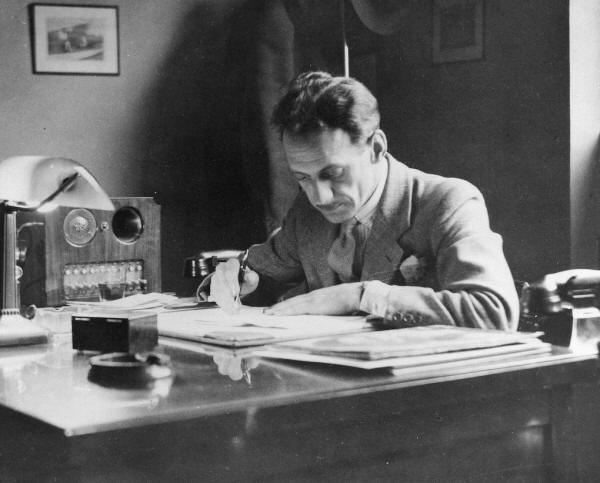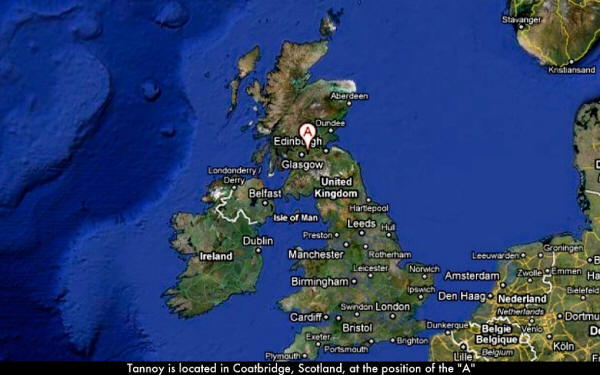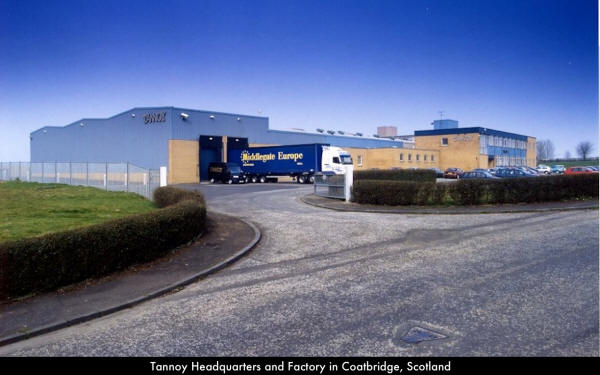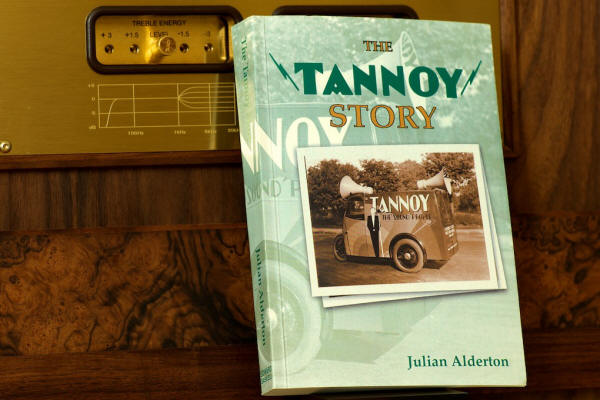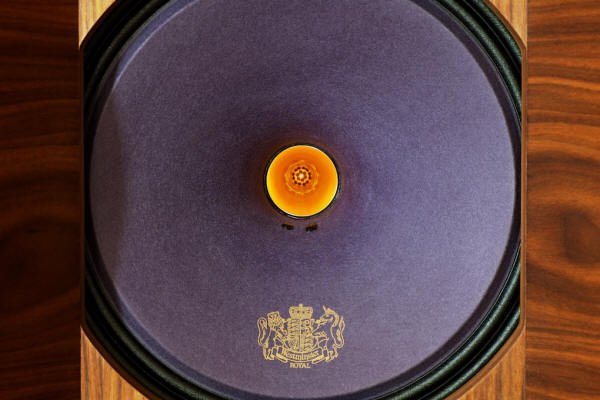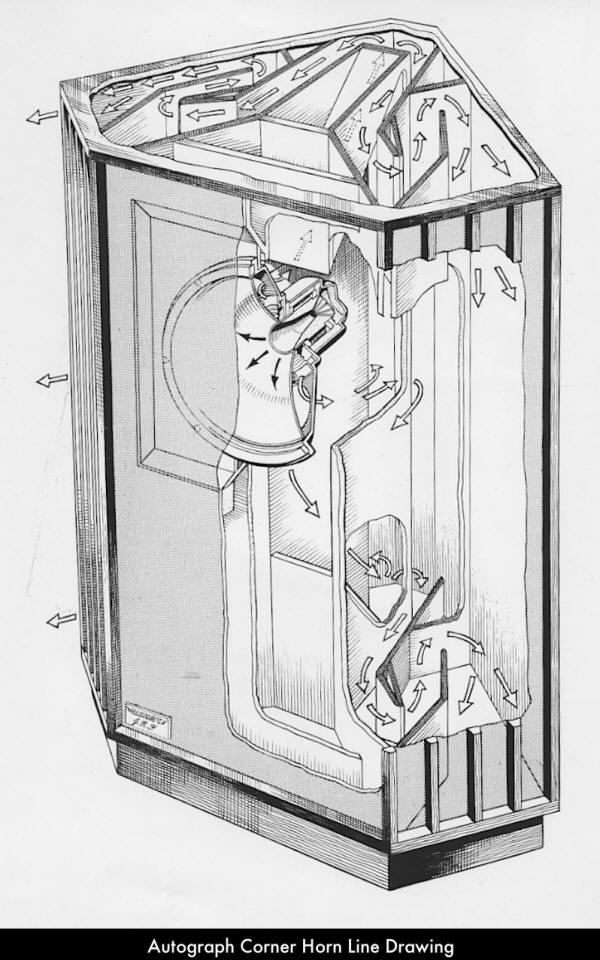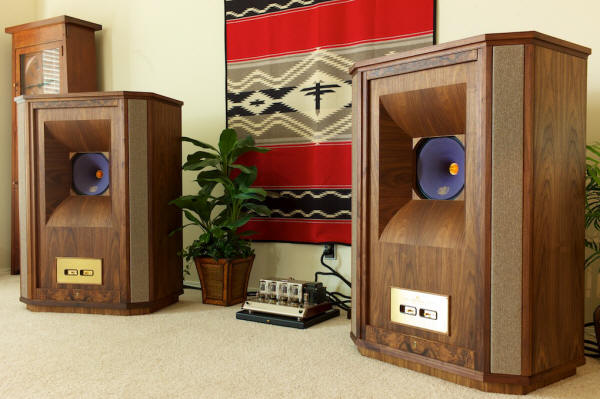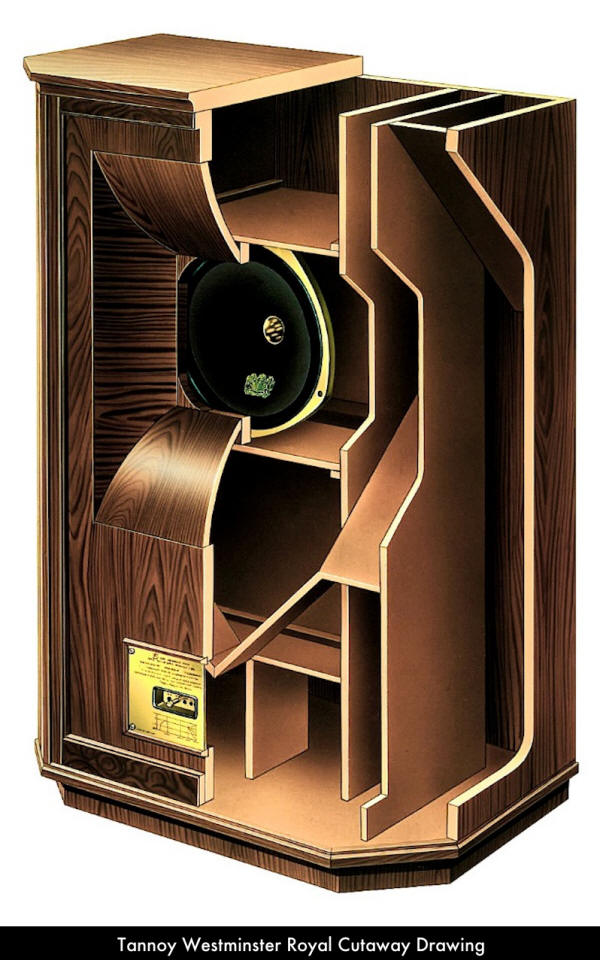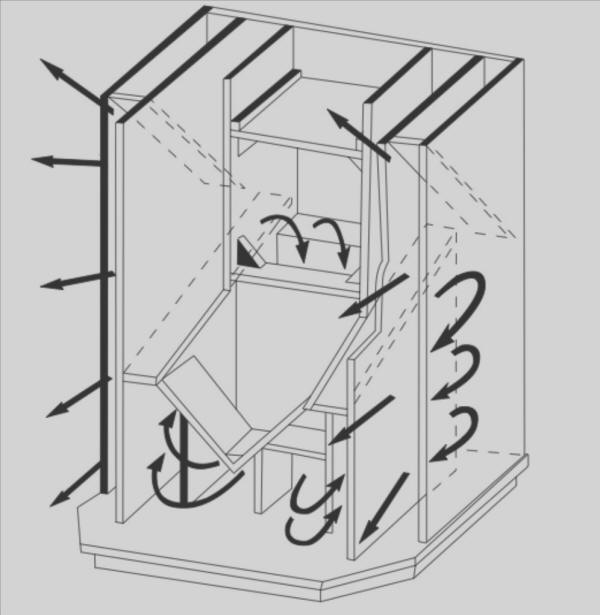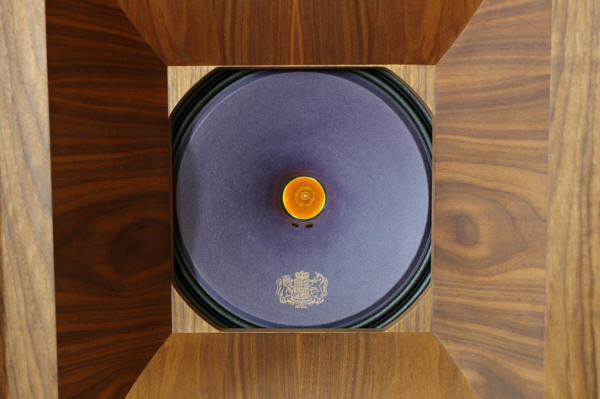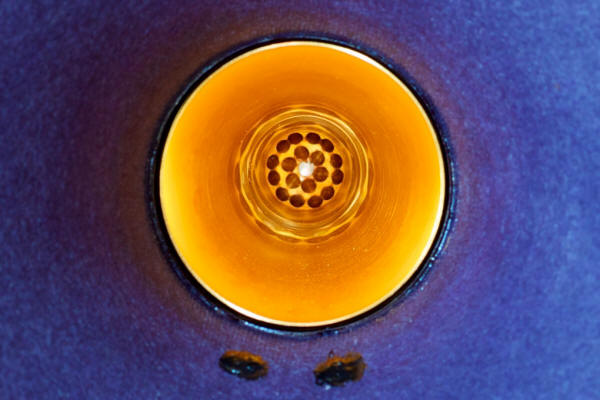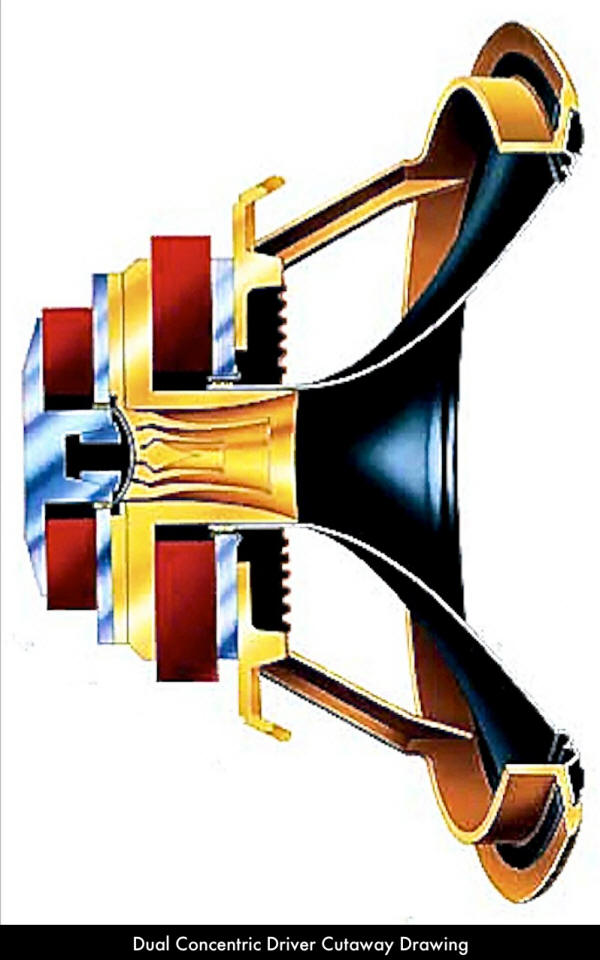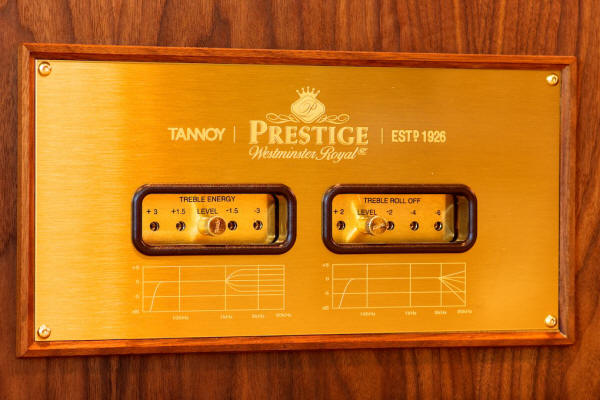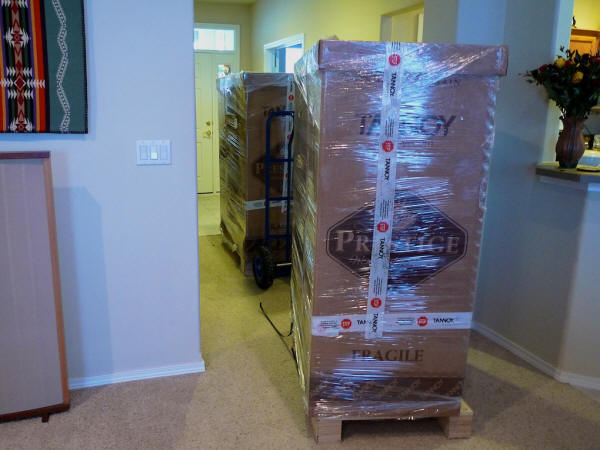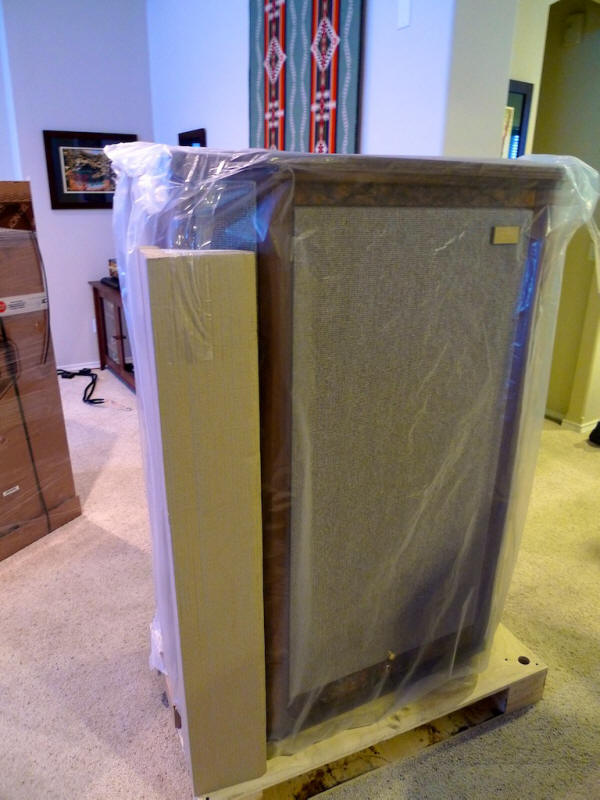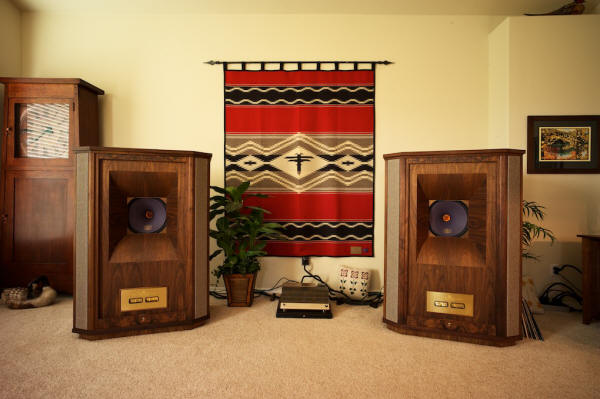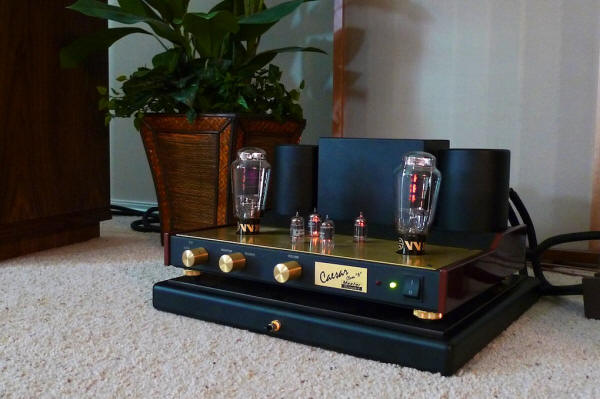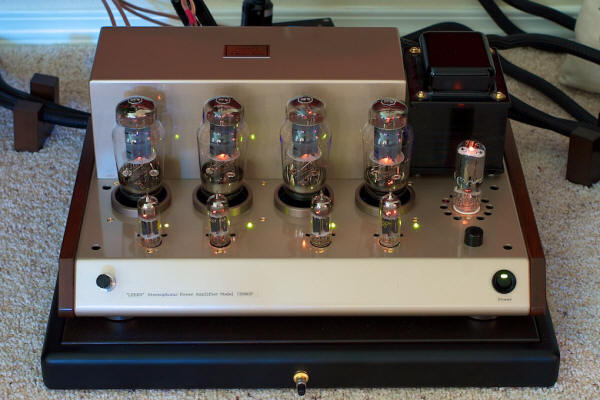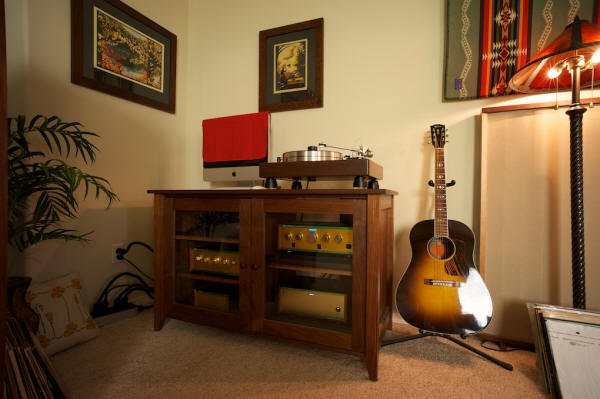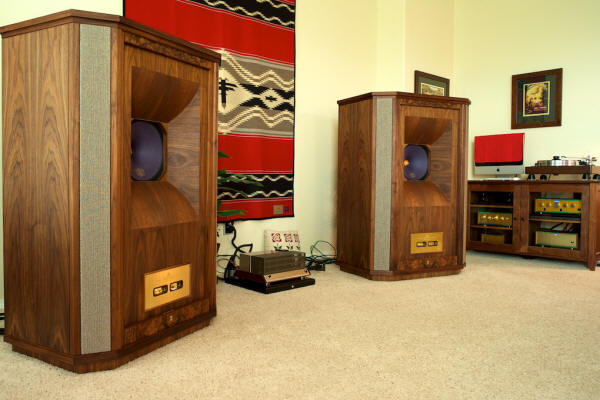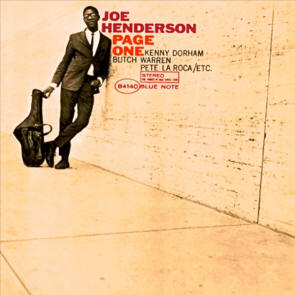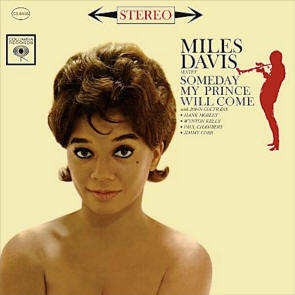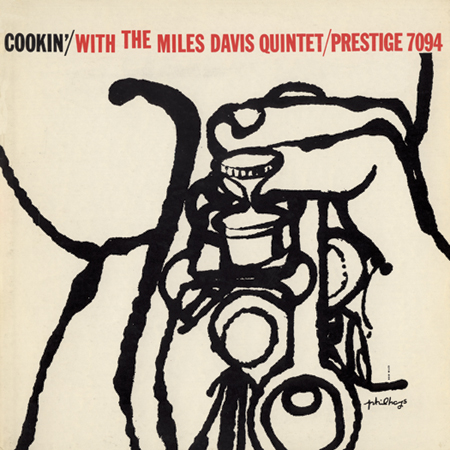|
You are reading the older HTML site Positive Feedback ISSUE 49may/june 2010
The
Tao of Tannoy: The Westminster Royal Special Edition
Loudspeakers
Do you know what the oldest loudspeaker company in the world is? If you guessed Tannoy you're exactly right, as Tannoy was founded by Guy R. Fountain in 1926 and has been making loudspeakers now for over 84 years. 'Tannoy' was trademarked as a name in 1928, and was located in London until 1975, when it relocated to Coatbridge, Scotland, where it still resides.
There is such a rich history associated with Tannoy that it's impossible to do it justice in a web-length article, so I won't even try. Rather, I'll focus on the Westminster Royal Special Edition loudspeaker that is the object of this article, and I'll direct you to an excellent book that covers Tannoy's rich and interesting history with the detailed treatment it deserves: The Tannoy Story by Julian Alderton, Edward Gaskell Publishers, 2004, ISBN 1-898546-58-4. I bought my copy of Alderton's The Tannoy Story at Amazon.com, and I highly recommend it to anyone who loves history and Tannoy loudspeakers.
If there is anything that is symbolic of Tannoy it is certainly the Dual Concentric™ speaker unit, which I think is one of the most important advancements in speaker technology ever developed in the history of audio (Westminster Dual Concentric™ shown below). Ronald Rackham developed the Dual Concentric™ speaker in 1948, the Monitor Black, which brilliantly integrated a high-frequency compression horn driver unit into the same axis as a fifteen-inch direct radiating low frequency driver on one chassis. Rackham also designed the Guy R. Fountain (GRF) and Autograph corner horn enclosures for the Dual Concentric™ speakers, which also quickly attained status in the music industry as high-performance designs. If Nobel Prizes were awarded for achievements in audio electronics, then Ronald Rackham would certainly be deserving of one for his contribution of the Dual Concentric™ speaker design—it is a positively brilliant musical device that has been highly revered by generations of music lovers.
The Tannoy series of Dual Concentric™ speakers and enclosures have impressed many music industry luminaries over the years, like Arthur Haddy, the chief recording engineer at Decca, who heard the Monitor Silver (successor to the Monitor Black) in 1951 and ordered it for the Decca studios in London. Dr. Dutton of EMI visited Tannoy in 1951 and heard the Monitor Silvers installed in the GRF enclosures, and was so impressed he ordered the combination for EMI's Abbey Road recording studios. Kingsway Hall, the BBC, and many others, followed their example and ordered Tannoy Dual Concentrics™ for their recording studio work. Tannoy's became so prolific in the music industry that there's a very good chance that those beloved recordings you've treasured all your life were originally mastered using Tannoy Dual Concentrics™, and I suspect they will still be at their most authentic best when played back over Tannoys today. The Westminster Royal Special Edition Loudspeaker Today's top of the line Tannoy Dual Concentric™ is the Westminster Royal Special Edition. You might think that Tannoy's naming of its premiere loudspeaker as the Westminster Royal is a bit pretentious, and that they are perhaps guilty of putting on airs, but actually the naming of the Westminster Royal is rooted deep in Tannoy's rich history and commemorates the installation of Tannoys in what was once the primary residence of the Kings of England, the Palace of Westminster. That original Tannoy installation in the Palace of Westminster, now serving as the home of Parliament, was tuned by none other than Ronald Rackham, the afore mentioned Father of the Dual Concentric™ design.
While the Tannoy Westminster may visually look like a vintage horn design, it is not. Rather, the Westminster Project was initiated at the request of Tannoy's longstanding Japanese distributors, TEAC Esoteric, to serve as a noteworthy successor to the famous Autograph corner horn that was designed by Ronald Rackham so many years ago. Alex Garner, the Technical Director at Tannoy at the time of TEAC Esoteric's request, did the acoustic development for the first version of the Westminster (those colorful reports that they are a long lost and born again design of Guy R. Fountain are merely a bit of delightful fiction). In 1987 Dr. Paul Mills joined Tannoy as a Senior Design Engineer (and is now Director of Research and Engineering), and helped Alex Garner, then the Technical Director of Tannoy, put the finishing touches to the Westminster Royal, the successor to the original Westminster, which was launched that year. Dr. Mills then took over development of the Westminster Project and has continued to develop the concept to make the Westminster Royal Special Edition what it is today. Like Ronald Rackham for his design of the Dual Concentric™, if the Nobel Prize Committee awarded Nobel Prizes in Audio, certainly Alex Garner and Dr. Paul Mills would have won awards for their brilliant design work that has brought us the original Westminster, and now the Westminster Royal Special Edition, one of the most noteworthy designs in the history of audio.
The second version of the Westminster, called the Westminster Royal, was produced from 1987 to 1998. The Westminster Royal had an even larger cabinet than the first Westminster, and was made more rigid by using thick birch plywood for its construction. The Westminster Royal also used better capacitors in its crossover and Van den Hul wiring throughout. The third version of the Westminster, called the Westminster TW (Tulip Waveguide) was produced from 1992 to 1998 in parallel with the Westminster Royal. The Westminster TW was a lower cost version of the Westminster that used a ferrite magnet instead of the more expensive (and better sounding) Alnico magnet, and had a smaller cabinet volume than the Westminster Royal. The fourth version of the Westminster, called the Westminster Royal HE, was produced from 1999 to 2007. The 'HE' in its name referred to the 'Hard Edge' impregnated fabric surround on the bass driver which stored less energy, and which gave it a faster and more articulate sound than its predecessors. That brings us to the fifth and current version in the evolutionary development of the Westminster Royal, the Westminster Royal Special Edition (SE), which was introduced in 2007. The Westminster Royal SEs have entirely hand built compound horn-loaded birch plywood cabinets, each with a volume of 530 liters, and weigh a hefty 304 pounds per loudspeaker. Internally the cabinets are cross-braced for rigidity and heavily damped to eliminate resonances that could degrade their sound quality. The cabinets are finished in beautifully applied book-matched walnut veneer, solid walnut trim, and walnut burl highlights—the overall effect is quite stunning and it can be quite hard to take your eyes off the speakers when listening to music at first. The cabinets are hand-waxed before leaving the finishing workshop, and Tannoy thoughtfully includes a specially formulated wax with the loudspeakers so new owners can keep them looking as good over time as they did when they were new. The cabinets have casters on their bottoms to aid moving them into position, and believe me they are an absolute necessity when trying to move these behemoths. The speakers come with machined cups that the owner can place under the casters for additional isolation after the speakers' final position is determined (which I haven't got around to trying yet). Each Westminster Royal SE speaker cabinet incorporates two 11-foot long rear folded horns—composed of 30 individual panels—that couple to the rear of the Dual Concentric™ drive unit and exit at the front cabinet corners (see the cutaway diagrams of the cabinets below). The rear horn starts acoustic coupling to the drive unit at 300Hz and provides low frequency response down to 18Hz (-6dB). Above 300Hz the low frequency drive unit is coupled to the front horn and provides frequency response in the range of 300Hz to 1000Hz. The high frequency compression driver component of the Dual Concentric™ drive unit provides frequency response from1000Hz to 20000Hz.
As you can see in the accompanying photos, the Westminster Royal SE's 15-inch Dual Concentric™ drive units are objects of beauty, with their elegant golden Westminster logo on the indigo low frequency driver cones, and their glowing, golden, high frequency Pepper-Pot Wave Guides™ (so named because its interior pattern of openings in the wave guide looks like the openings in a pepper shaker). The Westminster Royal SE uses the latest and most refined version of Tannoy's Dual Concentric™ 15-inch Alcomax 3 drive unit, which incorporates Alnico magnets and a computer designed and manufactured reverse throat high frequency Pepper-Pot Wave Guide™.
Alnico magnets are revered by horn loudspeaker aficionados for their incredibly lifelike tone, and in the Westminster Royal SE Alnico magnet assemblies provide flux generation for both the high and low frequency driver motors, maintaining a strong magnetic flux around each voice coil in its precision air gap. The Alnico magnets used in the Westminster Royal SE are Tannoy's most refined Alnico formulation to date, referred to as Alcomax 3, and has a iron-nickel alloy composition doped with cobalt, aluminum, and other rare (proprietary mix of) metals to provide magnets with "unparalleled sensitivity and clean transient response". The magnet assembly is housed in an extremely rigid high precision die cast chassis that keeps everything perfectly aligned in the Dual Concentric™ drive unit.
The high frequencies (1000Hz to 20000Hz) of the Dual Concentric™ drive unit are provided by a high performance 2-inch compression driver with a wide dynamic range whose acoustic output is routed through a multiple phase compensating device into the throat of a solid steel acoustic horn, where it goes through an impedance transformation that matches the compression driver's radiation to the room. The driver uses a aluminum-magnesium alloy diaphragm that is manufactured according to a precision five-step process that produces a grain structure aligned at the molecular level to provide high performance and long-term durability. The diaphragm is driven by a round wire voice coil that is an ultra-low mass aluminum design, and is wired with copper Litz wire for high performance and long-term durability. The acoustic cavity of the driver is damped to control its response and to match its impedance to the horn throat. The compression driver's response extends two octaves below the crossover frequency of 1000 Hz, which eliminates colorations that can arise due to operation over the fundamental resonance region. The 15-inch low frequency cone is made of a proprietary paper-pulp material that is treated to absorb internal resonance modes, and utilizes a reinforcing structure that gives it a very high stiffness to mass ratio that allows it to maintain very accurate pistonic motion over its frequency range. The low frequency cone has a damped twin roll fabric surround that is designed to be compliant and linear over the large excursions the driver is capable of. A high power motor that consists of a four-layer coil that is suspended in a very fine tolerance magnetic air gap drives the cone. The coil is wound using a special high temperature adhesive system and then goes through a curing process that ensures reliable operation at high peak power inputs the driver is capable of handling (e.g. 550 watts peak, 135 watts RMS).
As you can see in the cutaway drawing (below) of Tannoy's Dual Concentric™ drive unit, the flare profile is continuous from the high frequency Pepper-Pot Wave Guide™ out across the low frequency cone to provide optimum dispersion across the audio frequencies to give a smooth transition at the crossover point. One of the most important aspects of the Dual Concentric™ drive unit design is that it has all frequencies emanating from the same central axis, with the high-frequency exponential Pepper-Pot Wave Guide™, located in the center and behind the low frequency driver, perfectly integrated to produce polar sound dispersion that is symmetrical in both horizontal and vertical planes, a design aspect which has a huge advantage over multi-driver systems in coherency due to being in essence a point source, which I'll talk about more as I describe my listening impressions.
The crossover of the Westminster Royal SE is bi-wired for low and high frequencies, with hard-wired low-loss components in a passive design. The crossover is second-order on the low frequencies and second-order compensated on the high frequencies. Earlier versions of the Westminster Royal used a similar crossover design with only minor differences, but with the Westminster Royal Special Edition the crossover topology has been refined and the design has been taken to a new level of performance by using state-of-art Clarity Cap polypropylene capacitors, non-inductive thick film Vishay resistors, very low loss laminated core inductors custom made for Tannoy, and a combination of proprietary high purity silver & Acrolink six nines (6N) purity copper hard-wiring. The crossover allows the owner to adjust the high frequency energy and roll off.
As a point of clarification, the Tannoy Westminster Royal SE loudspeakers I'm writing about are not 'in for review' in the usual sense. Rather, they are a personal purchase. Normally I don't write formal reviews about personal purchases because, well, it takes a lot of time, and time is increasingly in short supply these days it seems, and frankly I'd rather be listening to music for pleasure instead of writing about it! However, in the case of the Tannoy Westminster Royal SE loudspeakers, I decided I couldn't not write about them because they are just so ridiculously good, and information is so hard to come by about them in the West, that it would have been a horrific disservice to music lovers everywhere had I not written about them. Let me back up a little bit to the beginning of this story. My journey to owning a pair of Westminster Royal SEs started like this: Quite a few years ago at the Consumer Electronics Show I heard a pair of Tannoy Churchill loudspeakers and they really impressed me. They had gorgeous tone and produced a visceral impact that I could feel over my entire body, and I was never quite able to get that experience out of my head. The Churchill is now a footnote in Tannoy's history, but in any event, I had fixed my attention on the Westminster Royal SE, Tannoy's most beloved loudspeaker. "Hey, if the Churchill was that awesome, the Westminster Royal SE must even be more awesome," was my logic (and hope). So I did what a lot of us have to do with exotic Hi-Fi equipment that's not easy to audition, due to their scarcity, I ordered a pair without having heard them and hoped for the best. That's a little scary when you're talking about a loudspeaker that sells for about as much as I paid for my Toyota 4Runner when it was new, which was my single largest purchase ever next to my house. So for an average guy like me, it was a huge step to place that order for the Westminster Royal Special Editions. Tannoy makes each pair of Westminster Royal SEs as an order is received, so it takes a while from the time you place an order until they make your pair, test them, and then ship them. I settled in for the long wait for Tannoy to make my Westminster Royal SEs and deliver them to me in the USA from their factory in Coatbridge, Scotland. Well, the wait wasn't really that long I suppose, it just felt long because I was so excited about getting a pair of Tannoy Westminster Royal SEs. I ordered the big West's on October 19, 2009, and I got a call from FedEx on December 30, 2009, that they had made their way safely from Coatbridge, Scotland, and were now in town and ready to be delivered to my residence. The FedEx driver helped me get the big shipping containers for the Westminsters out of the truck and into my entryway. I call my buddy Chad asking for some help to get them uncrated, and fortunately he was able to come to the rescue. The Westminsters sit upon interlocking pallets, and given that each of them weighs over 300 pounds, Tannoy recommends 5 people to lift them off their pallet.
Chad and I stared at the crates for a while trying to figure out how just the two of us were going to do what Tannoy recommended for five men. First we removed the shrink-wrap from the shipping containers, and then lifted off the cardboard containers and set them aside. Then we removed the internal foam packing that is shrink-wrapped to the speakers and set it aside.
According to Tannoy's directions, essentially you have to do a dead lift of the loudspeaker straight up off the pallet to clear the interlocking blocks, remove the pallet from underneath the speaker, and then set the speakers down. That means that each of the 5 men recommended would only have to dead lift a little over 60 pounds each. But there were only two of us. Chad, an engineer, looked over the foam beams that protected the corners of the loudspeaker during shipping and noted how robust they were, and that they were the same length as the speaker. "Aha!" he said, "We can place the beams under the back of the speakers, lay the speaker down on them, and because the speaker pivots on its axis it means each of us only has to lift 75 pounds." Brilliant. So that's exactly what we did, and then pulled the pallet out and set it aside, and tipped the speakers back upright. We wheeled the Westminsters in place (thankfully they have casters on the bottom), and then did a rudimentary setup and got them up and playing. Holy cow! What great sounding speakers! We listened to record after record that night and we were blown away with the Westminsters – and they weren't even broken in yet! As I would find out later, they get significantly better with more time on them, and now they are now sounding positively otherworldly.
I've found the Westminsters to be a bit picky about associated equipment, as they are quite neutral. You can make them sound slow and dull with poor equipment choices, or conversely bright and edgy. However, they are utterly magical, musically colorful, naturally life-like, and astonishingly expressive when matched with the right associated equipment. Of the different equipment I've listened to, I've come up with a few general guidelines for associated equipment matching that works well in my room to make the Westminster Royal SEs really sing: I've found the Westminsters to be at their best with associated equipment that is tonally rich and colorful, extended and well behaved at the frequency extremes, smooth, transparent, and somewhat detailed (but not etched sounding). Just a note on amplifiers: Use vacuum tube amplification, even really good solid-state amplification gives up too much performance. Given the 99dB sensitivity you would think any of the DHT SET amps out there would work fine, but in practice I've found that anything below about 5 watts just really couldn't make them sing and swing at levels that are typical of live music, so you'll want to look for something bigger than a 45 or 2A3 amp if you listen to dynamic music played loud. If you listen at low levels the majority of the time you can easily get by with a 2A3 amp, but you'll never be able to hear what the Westminsters are really cable of dynamically. To date, the two best matches for amplification have been the MasterSound Caesar 300B integrated amplifier from Italy that my friend Ron brought over for a listening session, and my own Leben CS660P power amplifier from Japan. The Caesar is a beautiful little amplifier that is made to an extremely high quality standard, and its 9 watts sounds massively powerful on the Westminsters even on the most bombastic pieces played loud. It's a very transparent amp with a lot of natural resolution of detail, is a lot of fun to listen to music with, and is one of the best amplifiers I have ever heard. My Leben Hi-Fi Company CS660P power amplifier at about 40 watts is way more power than you really need on the Westminsters, but it does give plenty of reserve power for those dynamic peaks in the music.
Keep your eye on these: I was very impressed with the prototype deHavilland Model 50A mono amplifiers made by tube wizard Kara Chaffee in the brief audition I had of them on my Westminsters. I haven't yet heard the production versions, but if they're anything like the prototypes they will be stunning. A couple of my pals have already bought pairs so I'm hoping to get a more extended listen soon. You can see my current equipment list, a combination of equipment that really gets the best from the Westminster Royal SEs, at my personal blog here.
Listening It's been fun having friends over for listening sessions with the Westminster Royal SEs in residence. From that first playing of music with Chad after unpacking them, right up until now, we've all been blown away by the sheer musicality of the Westminsters, and we are a picky and hard to please crowd of musicians, music lovers, Hi-Fi enthusiasts and writers, including a couple of Hi-Fi dealers, and even a few Hi-Fi manufacturers. That's the first time in my recollection that there's been such universal praise for a pair of loudspeakers among that group of picky listeners—it's unprecedented! There is something magical and seductive about the combination of full-range horn loudspeakers like the Tannoy Westminster Royal SEs, vacuum tube electronics, and vinyl as a source—it is just so inherently musical that all of my analytical reasoning gets pushed aside and I just melt into musical ecstasy. That's saying something for someone who has a Doctorate in analysis (literally), because I can quite easily get caught up in the 'paralysis of analysis' due to my pointy-headed training if I'm not careful. Yet the Tannoy Westminster Royal SE completely disconnects my analysis pathways, and I melt into the music. It's like magic!
I get quite a few people asking me what the Westminster Royal SEs sound like, so I'll start with a very general description, and try to elaborate from there. First of all, as you would expect from their size, they sound big. Big in the way music sounds live, and if you closed your eyes for a moment, you could be forgiven for thinking that the music coming through them is coming from musicians playing live, that you're hearing them through a very refined sound system, although I doubt there's many venues where the music sounds as good as when coming through the Westminsters. The Westminster's presentation of recorded music is energizing, life-size, and powerfully moving, much in the same way live music is. As I've mentioned earlier, the Westminster's overall sonic character is largely determined by the way you've voiced them in your room via your equipment choices. I've chosen associated equipment that makes them sound just a little bit dark and warm overall, with high frequencies that sparkle like starlight through a pitch black night, and with deep, taut, and articulate bass response. The Westminsters voiced thusly have a big, richly colorful tone, and a very natural presentation that is surprisingly agile and transparent, not something I would have expected from a big 15-inch driver. Perhaps the Westminster Royal SE's most notable attribute is how visceral the musical experience is through them. You can literally feel the sound waves of the music flow over and interact with your body in a way that is uniquely tangible compared to any loudspeaker in my experience. The most vivid example of this is the bass response, which can quite literally rattle your ribs in your chest. But the effect is not limited to bass, it's pretty much that way across the frequency range, where I can feel it energizing my body much in the same way live instruments do, and more than one visitor to my listening room has commented on how involving this phenomena is. Another aspect of the Westminster's overall presentation, at least when setup like I've described above, is that they can play at very loud levels without my ears shutting down. I'm not sure if it is their very low distortion, the point-source-like delivery of the Dual Concentric™ drivers, or the enormous wave front that washes over you during listening, but I've found that they defeat that 'strained' feeling I normally get as volumes increase, which allows for listening at higher levels than I am used to with other loudspeakers. A caveat is in order: because of this sense of ease at loud volumes, you have to be a little bit thoughtful about listening at loud levels for long periods, as you will surely be tempted to do so with the Westminsters, and that could damage your hearing over time. So I'm just saying, be a little careful not to overdo it to your own detriment. Ok, that's enough of a general description; let's listen to some music. Since my VPI Classic turntable arrived a few weeks ago I haven't listened to digital for more than a total of 5 minutes. Not that my digital front end isn't wonderful, it is, but after listening to vinyl, particularly vinyl as good as the new 45 RPM Blue Note Reissues from Analogue Productions, it quickly dispelled in my mind any idea that good digital can compete head-to-head with good analog. This morning I've been listening to Joe Henderson's Page One 45-RPM LP set, and it is incredible, and stands shoulder to shoulder on the podium with any of the greatest jazz LPs ever pressed.
Kenny Dorham's Blue Bossa is Side One of the LP set, and at about a minute into it he takes off on a trumpet solo that sent a pleasurable shiver down my spine with it's pulsating vibrato. Through the Westminsters, Kenny's tone is mind boggling beautiful, with its Latin bossa nova infused hard bop lines, with no edge or grit, but smooth and liquidly flowing, burnished, and yet still able to keep me on the edge of my seat. From a sonic standpoint you get well-defined life-sized flesh & blood images, a deep soundstage, and a lot of musically natural detailed suffused with a large sense of space. Musically it is sheer ecstasy, with deeply colorful instrumental trumpet (Dorham) and sax (Henderson) tone played by masters of their instruments. Henderson takes a solo after Dorham, and it is one of his best. The upright bass (Butch Warren) is taut and moves the music along nicely, and every note's pitch is obvious—no one note bass issues with the Westminsters—they display Butch's playing in its full glory. The improvising, the backing… man it is just out of this world, and I'm really finding it difficult to articulate the sheer mesmerizing beauty of this music through the Westminsters. McCoy Tyner's piano playing emerges out of the center of the mix from way back in the soundstage, with his distinctive voicing of chordal structures and melodic phrasings. Pete La Roca's drum playing is perfection. Joe's Recorda Me (means 'remember me' in Portuguese) is the first cut on Side Three of the LP set, and it is quite simply sax soloing perfection… and I'm going stop there, because you really just need to get this album and listen for yourself. You will not regret it – this is one of the great jazz albums. Page One through the Westminsters is an experience, an experience you'll never forget, and will make it clear why you got into this crazy Hi-Fi hobby to begin with. The Westminsters truly leave me at a loss for words in articulating how intensely involving music this music is through them. I'm a big Miles Davis fan, and one of my favorite Miles Davis albums is Someday My Prince Will Come, so I could hardly wait to unpack the Analogue Productions 45-RPM version that I ordered a little while back and listen to it through the Westminsters. In case you're wondering, the pretty girl on the album cover was Frances, Miles' wife (man, some guys have all the luck!). It's not just the album's cover that is impressive though, because Prince features John Coltrane (tenor sax on Someday My Prince Will Come and I Thought About You), Hank Mobley (tenor sax on all tracks except I Thought About You), Wynton Kelly (piano), Paul Chambers (bass), Jimmy Cobb (drums), and of course Miles Davis (trumpet). The songs covered are Someday My Prince Will Come, Old Folks, Pfrancing (a Punny contraction of Frances' name and dancing—really!), Drad-Dog, I Thought About You, and Teo. I'll tell you what, there's never been a copy of Prince that even comes close to the quality of the Analogue Productions 45-RPM version—it's just freaky good! Miles Davis' trumpet is perfectly portrayed, being piquant, but never edgy or harsh. Jimmy Cobb's cymbal work sounds so real it'll give you chicken skin. Paul Chambers' bass playing is insistent in driving Prince forward, and his bass sounds big, taut, and defined. The Westminsters can really carry a tune, with the melody pulling you in, and the tempo sailin' along, just like it should. Lest I forget, let me mention now how life-size and solid images are, and they're spread across a wide and deep soundstage. How big is the soundstage through the Westminsters? On Prince it's as big as the stage at a nice little jazz club, in other words it's BIG, even life sized. The Westminsters immerse you in a huge ambient soundspace as well, making you feel like you're a couple of tables away from a performance at Seattle's Jazz Alley.
My trusty old Analogue Productions 33-RPM test pressing of Cookin' With the Miles Davis Quintet (recorded in 1956) isn't so shabby either, even if it's not quite up there with the 45-RPM reissues, and is another one of my favorite Miles Davis albums. Cookin' features Paul Chambers on bass, John Coltrane on tenor sax, Miles Davis on trumpet, Red Garland on piano, and Philly Joe Jones on drums, and is an altogether terrific set of music. I'll tell you what, when the Westminsters are playing Cookin' at a volume that approximates live music it will stir you body & soul with the music with an intensity that you experience in life—the West's nail the sound and feel of live music. A few pointy headed observations: The Westminsters reproduction of believable instrumental timbre for the bass, tenor sax, trumpet, piano, and drums on Cookin' really helps the illusion of live music along, as does the way the Westminsters portray the time elements of music like tempo, melody, and rhythm. For example, Paul Chambers' bass sounds woody, taut, and appropriately defined (with just the right amount of string slap and sloppiness at times) that you could be forgiven for thinking that someone was playing a bass down the hall if you had just walked into my house. I get the same sort of musical sensibility hearing the Westminster reproduce Paul's driving bass lines that I get from hearing an upright bass in life, and his forward momentum drives the music along beautifully, just like in life. Miles' trumpet has its characteristic bite, but never sends you running for cover the way it does with some speakers. The Westminsters portray horns beautifully, perhaps because they are horns themselves and can track the dynamics of Miles' and Coltrane's playing easily and realistically. Wrapping Up I quite literally could go on and on telling you how wonderful and powerfully emotive vocals are through the Westminsters, or how they make huge classical performances as intimate and involving as small group jazz, or how you're transported to Seattle's Tractor Tavern when listening to bluegrass with the Westminsters, or how they can play rock & roll at live levels, levels that make you want to get up out of your seat and dance to the music (as more than one visitor to my listening room has done), but I won't, because I want to finish up my writing now so I can get back to listening to music for fun, and believe me, the Westminsters are unparalleled in the fun department. In wrapping up, I am reminded of a question posed to me by one of Positive Feedback Online's readers, who e-mailed me asking me to discuss my experiences with three loudspeakers I have owned that he was interested in, to help give him ideas about what to do next. Those three loudspeakers are the Avantgarde Duos, the Harbeth Monitor 40.1s, and the Tannoy Westminster Royal Special Edition loudspeakers. After thinking about it, I decided a distillation of that conversation would also be useful to readers of this review. First of all, I should point out that these are three very good and very different loudspeakers, and I think they will appeal to different listeners based on their needs and tastes. For example, room size is an important consideration for any of these speakers to perform at their best: for the Westminster Royal SEs to perform optimally I think your room should be at least as long as a 18Hz half-wave (the West's bass extension), or about 30 feet. For the Harbeth Monitor 40.1s, I think they are at their best in a fairly small room, reasonably close to a size of 3x4 meters or thereabout (which is the size of room they were optimized in during Alan Shaw's design process), or their bass tends to become unbalanced and boomy. The Avantgarde Duo is more flexible due to its tunable bass module, so it can be optimized for a larger variety of rooms size-wise, but still it prefers a larger room to a smaller one like the Harbeth is happiest in. Then there is loudspeaker sensitivity and amplifier choice: The Avantgarde has > 100dB sensitivity, which means you can use any of the low power single ended triode (SET) amplifiers of 1 watt or more and get adequate sound pressure levels. The Westminster Royal SE has 99dB sensitivity, which I have found to work best with amplifiers of 5 watts or more, which excludes some of the smallest SETs like those based on 45 and 2A3 tubes. The Harbeth Monitor 40.1 has 85dB sensitivity, and that means more powerful amps must be used with them to get adequate sound pressure levels. Even though the Harbeth is rated as having a rather low 85dB sensitivity, the rating is a little misleading, as it is easier to drive than its low sensitivity rating would suggest, but still, for most listeners that means amps in the 30 - 40 watt range or bigger. Then there is the voicing of the loudspeaker, and which one is preferential will be largely a matter of a given listener's taste: the Harbeth sounds like a classic monitor, and when used as intended in a small room for near field listening it is evenly balanced, detailed, and tonally neutral but not fatiguing, assuming your associated electronics are not. The Avantgarde is a bit tricky to integrate completely for a coherent sound because it uses two different technologies: two horn loaded drivers that are very fast and a powered bass module that isn't quite as fast. When optimized it can sound quite good, kind of like a highly sensitive Harbeth Monitor 40.1 perhaps, with a detailed, neutral, and very dynamic sound. Tonal balance will largely be dependent up associated equipment, which can range from warm & lush to cool & detailed depending on the equipment. Then there's the Westminster Royal SE, which uses a Dual Concentric™ driver that behaves essentially as a point source, making it by far the most coherent and balanced top to bottom of these three speakers. It is quite a different listening experience because of the Dual Concentric™ driver than the other two loudspeakers, which effectively allows music to take on a level of naturalness of presentation that is remarkable by any measure. The Westminster sounds big, and more like live music than the other two speakers, and it provides a visceral experience that is unparalleled in my experience—it can quite literally rattle your ribs in your chest with certain music. The Westminster Royal SE is unique in that you not only hear it, but you can also feel the musical waveform over your entire body, even at moderate listening levels, which is one of its rather endearing traits. Which one of the three do I prefer when they are optimized in a way that brings out the best of their performance? I prefer the Westminster Royal SE by far. As listener after listener that has visited my listening room have said, the Westminsters are really something special, and are a couple of levels above either the Avantgarde or Harbeth in performance (or as my friend Chad puts it, the Westminsters are in a totally different league). But they should be considering the price differential: the Harbeth is around $12K, the Avantgarde Duo is double that, and the Westminster is triple that. In the case of the Westminster Royal SE, you really do get what you pay for though, and using the Stereophile rating system that places the Avantgarde and Harbeths in Class A, the Westminsters are simply off the rating scale above Class A somewhere up there around the North Star. Conclusion As my friend Ron said after hearing the Westminsters, "Where do you go from here!" Well, for me, nowhere. I'm finally done searching for loudspeakers that I can live with and love for the long haul. For me, the Westminster Royal SE represents the end of long a journey through many different loudspeakers, all of them good, but in the Tannoy Westminster Royal SE I've finally found 'my' perfect loudspeaker. I like everything about them, and I can't imagine living without them. I hope I never have to. For those who are interested in reading more about my experiences with the Westminsters over time, I will be chronicling my long-term thoughts and experiences at my personal blog, Jeff's Place. Pricing: $35,000 USD. Quality of construction: Superb. Condition of products received: Perfect. Human interactions: Many thanks to Tim Lount, Lynne Kerr, Darrin Kavanagh, Jennifer Kavanagh, Jenny D'Andrea, Fraser Sanaghan, and Jason Sousa of Tannoy, they were all a delight to work with, and provided first rate service at every turn whether it was getting my speakers ordered, delivered, or helping me with the information for this article—very much appreciated! Tannoy: http://www.tannoy.com
|

